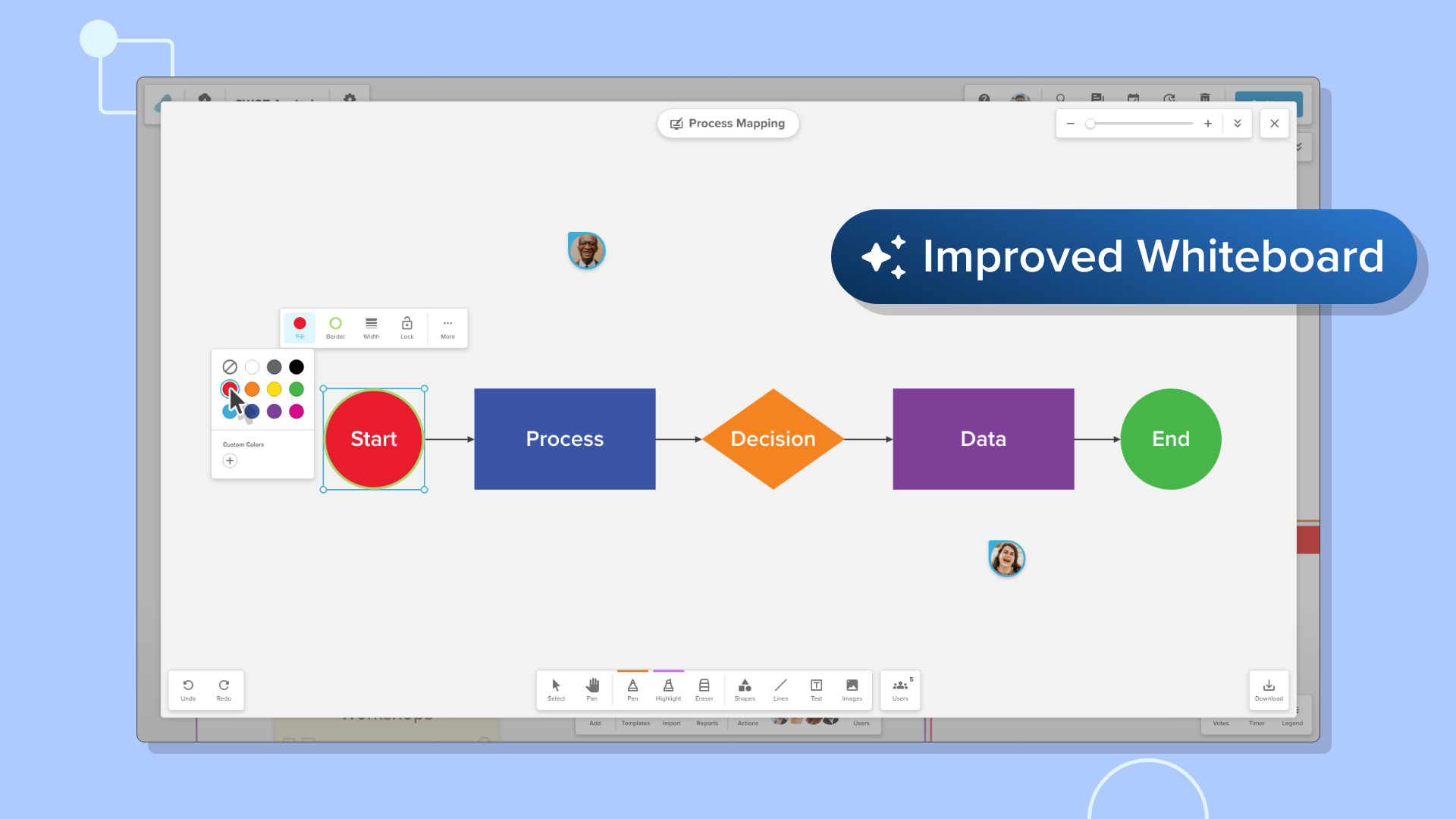How Data-Driven Culture Guides and Improves Your Business
In the past, companies relied on assumptions, past trends, and historical success to deduce the best course of action.
However, with the world becoming more sophisticated every year, these methods may leave you and your company falling behind.
It can be difficult to change the way decisions are made in an organization. It requires buy-in from senior leadership and a commitment to data-driven decision-making from everyone in the company.
The benefits, however, are clear. A data-driven culture leads to better decisions, which result in improved business outcomes.
Studies show a decline in companies that qualify as having a top-tier data culture. In 2021 it was 29%, but this year it’s dropped to a mere 15%. This means business leaders who are interested in a data-focused methodology are having trouble keeping it up long term.
So how can you create a data-driven culture that not only increases productivity and improves your company’s decision-making processes, but also becomes so integral that it continues to impact you far into the future?
What is data-driven culture?
Before we jump into making a resilient data-driven culture, let’s ensure we know precisely what that would look like.
Data-driven decision-making is a process that relies on data and analytics rather than intuition or experience. Businesses that successfully adopt it guide their actions with facts, not assumptions. This allows them to avoid costly mistakes and pursue opportunities with confidence.
Adopting a data-driven culture is not about randomly collecting data and then analyzing it afterward. It’s a proactive approach in which data is collected with specific decisions in mind. A data-driven workplace will find that it cannot function without a constant flow of information.
Consider how a data outage would affect your workplace. Would operations be able to continue for a few hours, days, or even weeks? How would this lack of information affect different departments within your organization? These questions are a great litmus test to see if your efforts to cultivate a data-driven culture are finding success.
The advantages of a data-driven culture
It will be a lot of work to integrate data fully into your business, so it is helpful to remember the return on this investment. Here are some of the many benefits of instituting a data-driven culture.
Improved customer satisfaction: When you have a clear understanding of what your customers want and need, it’s easier to give it to them.
Better decision-making: Data also allows you to see things that you would otherwise miss, giving you a more complete picture of your situation. You’ll be able to make confident decisions quickly because you can see all the factors involved.
Reduced waste: Collecting and analyzing data can help you identify areas where you’re wasting money. Once you know where the extra spending is occurring, you can take steps to reduce or eliminate it.
New growth opportunities: By targeting your marketing and product development efforts to areas where you know there is demand, you can increase your revenue without having to spend a lot of extra money.
Increased transparency: Data-driven cultures are typically more transparent than those that rely on intuition or experience. This will allow you to build trust with your employees and customers by being open about how you make decisions.
Elevated teamwork: When everyone understands concepts like coding and quantitative topics, they can operate as one entity moving towards your goals.
Each of these benefits can have a profound impact on your business.
How to infuse data-driven culture into your business
There are three main tenants of a data-driven culture: discovery, literacy, and governance. To make the changes stick, you’ll need to focus on all three.
Data discovery is the process of finding data that is relevant to your business. This data can come from internal sources, such as customer data or financial records, or external sources, such as social media or market research. The key is identifying what will help you make better decisions.
Data literacy is the ability to read, understand, and use data effectively. It includes understanding different types, knowing how to clean and analyze data, and being able to communicate findings clearly and concisely. Data literacy is essential for all employees, not just those in data-related roles.
Data governance is the process of ensuring that data is accurate, accessible, and secure. It includes developing policies and procedures for managing data, as well as creating systems to monitor quality. It is critical for protecting your company’s data assets and ensuring that they are used effectively.
Changing the way your company operates can be daunting, but the benefits of a data-driven culture are too great to ignore. By focusing on each of these techniques, you can make the necessary changes.
Leadership
Adopting a data-driven culture requires buy-in from all levels of the organization. The most successful companies are those that make data-driven decision-making a part of their DNA. They infuse data into every aspect of the business, from the top down.
This starts with leadership setting the tone and making data-driven decisions themselves. Employees will follow your examples. Work to include data analytics in every decision you are making. Consistency is key. If you are not fully dedicated to this shift, you can not expect your teams to be.
You will want to ensure that your process is creating results quickly so that you can build momentum. The entire company will be excited about data integration if they can see results right away.
This requires your first changes to be simple but effective. Start your changes small, like increasing data collection or automating a part of your process. Once these proofs of concept are up and running, it will be easier to convince people to take bigger steps forward, because you will have the data to back you up.
Literacy
Many of the problems that arise when companies try to adopt a data-driven culture can be boiled down to a lack of skill within their workforce. For data to become a part of their daily lives, the bulk of your staff must understand how to read and communicate data insights.
There are a few ways to make this happen. You will not want to hire all new employees with skills in data analytics. Your current workforce understands your company and what’s important to it.
You’ll want to bring your data science team into your other departments and start having them work more collaboratively. Training every member of your team on how to successfully utilize data is a must, as a successful data-driven organization will have workers that are eight times more likely to use data in their day-to-day operations.
However, you don’t want to overwhelm your workforce with new information and practices. You should only teach people what they need to know to do the work they are doing so that they use the skills and improve upon them. Too much information can get lost and they will end up going right back to the old system.
A great way to help with this process is to invest in automation and show employees how much easier their lives will be if they focus on using data and artificial intelligence to improve their workflow.
Systems
You will not be able to reap the benefits of a data-driven culture if your data is not useful. Ensure that you are harvesting information with a specific goal in mind and that everyone in your organization is looking at the same numbers.
Any issues with data access need to be dealt with as soon as they come up. Democratized data is key to keeping a workforce invested in data analytics. If they can not quickly access data they will continue to operate without it.
This also empowers employees to take an interest in data and frees up your data analysts to focus on strategy and troubleshooting. Integrating your analytics tools into your daily process is crucial.
For example, using a system like Stormboard to help pull data from meetings, planning session, or even calendars will instantly show people how easy a data focus can be and help provide some of the important information your team will use to make decisions.
You’ll also want to mitigate risks by investing in software that will keep data secure and private. Everyone in a data-driven culture is responsible for protecting their digital assets, so don’t neglect the privacy of your systems.
Conclusion
83% of CEOs want to foster a data-driven culture in their businesses. This process is truly what will help you make the right decisions by making data available to your team and improving every part of your company.
Consistent use of the perfect tools is the best way to start building foundations for a culture that lasts. You need something secure, easy to use, and analytically rich to keep your team on the right track.
Stormboard is an excellent resource for keeping your team in constant communication, allowing access to data at any time and creating reports to analyze every step of the way.
The sooner you start, the sooner you’ll be able to reap the benefits of a data-centric workforce. Let the experts at Stormboard set your business up to start thinking about data differently.
Schedule a no-obligation product demo with a Stormboard expert today and allow us to show you exactly how we can turn your data and ideas into actionable outcomes.
About the author:
A programmer by trade, Nick Saraev is a freelance writer and entrepreneur with a penchant for helping people excel in their careers. He's been featured on Popular Mechanics & Apple News, and has founded several successful companies in e-commerce, marketing, and artificial intelligence. When he's not working on his latest project, you can find him hiking or painting.










